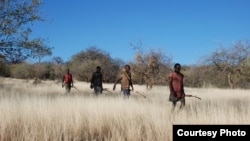Humans share a mathematical pattern of movement with other animals ranging from sharks to honey bees, according to new research.
The pattern, called a Lévy walk after French mathematician Paul Lévy who specialized in probability theory, involves a series of short movements in one area and then a longer trek to another area. Its use is not limited to searching for food.
Furthermore, the walk seems ubiquitous to animals and is similar to the golden ratio, phi, a mathematical ratio that has been found to describe proportions in plants and animals throughout nature.
“Scientists have been interested in characterizing how animals search for a long time,” said David Raichlen, an associate professor in the University of Arizona School of Anthropology, “so we decided to look at whether human hunter-gatherers use similar patterns.”
The group they decided to study is the Hadza people of Tanzania, one of the last big-game hunters in Africa, and one of the last groups on Earth to still forage on foot with traditional methods.
“If you want to understand human hunter-gatherer movement, you have to work with a group like the Hadza,” Raichlen said.
Members of the tribe wore wristwatches with GPS units that tracked their movement while on hunting or foraging bouts. The GPS data showed that while the Hadza use other movement patterns, the dominant theme of their foraging movements is a Lévy walk.
Studies have shown that humans sometimes follow a Lévy walk while ambling around an amusement park. The pattern also can be used as a predictor for urban development.
“Think about your life,” said Raichlen, who led the study. “What do you do on a normal day? Go to work and come back, walk short distances around your house? Then every once in a while you take these long steps, on foot, bike, in a car or on a plane. We tend to take short steps in one area and then take longer strides to get to another area.”
Following a Lévy walk pattern does not mean that humans don’t consciously decide where they are going, Raichlen said. “We definitely use memories and cues from the environment as we search,” he explained, “but this pattern seems to emerge in the process.”
In future studies, Raichlen and his colleagues hope to understand the reasons for using a Lévy walk and whether the pattern is determined by the distribution of resources in the environment.
“We’re very interested in studying why the Hadza use this pattern, what’s driving their hunting strategies and when they use this pattern versus another pattern,” said Pontzer, a member of the research team and an anthropologist at Hunter College in New York.
The study appears in the Proceedings of the National Academy of Sciences.
The pattern, called a Lévy walk after French mathematician Paul Lévy who specialized in probability theory, involves a series of short movements in one area and then a longer trek to another area. Its use is not limited to searching for food.
Furthermore, the walk seems ubiquitous to animals and is similar to the golden ratio, phi, a mathematical ratio that has been found to describe proportions in plants and animals throughout nature.
“Scientists have been interested in characterizing how animals search for a long time,” said David Raichlen, an associate professor in the University of Arizona School of Anthropology, “so we decided to look at whether human hunter-gatherers use similar patterns.”
The group they decided to study is the Hadza people of Tanzania, one of the last big-game hunters in Africa, and one of the last groups on Earth to still forage on foot with traditional methods.
“If you want to understand human hunter-gatherer movement, you have to work with a group like the Hadza,” Raichlen said.
Members of the tribe wore wristwatches with GPS units that tracked their movement while on hunting or foraging bouts. The GPS data showed that while the Hadza use other movement patterns, the dominant theme of their foraging movements is a Lévy walk.
Studies have shown that humans sometimes follow a Lévy walk while ambling around an amusement park. The pattern also can be used as a predictor for urban development.
“Think about your life,” said Raichlen, who led the study. “What do you do on a normal day? Go to work and come back, walk short distances around your house? Then every once in a while you take these long steps, on foot, bike, in a car or on a plane. We tend to take short steps in one area and then take longer strides to get to another area.”
Following a Lévy walk pattern does not mean that humans don’t consciously decide where they are going, Raichlen said. “We definitely use memories and cues from the environment as we search,” he explained, “but this pattern seems to emerge in the process.”
In future studies, Raichlen and his colleagues hope to understand the reasons for using a Lévy walk and whether the pattern is determined by the distribution of resources in the environment.
“We’re very interested in studying why the Hadza use this pattern, what’s driving their hunting strategies and when they use this pattern versus another pattern,” said Pontzer, a member of the research team and an anthropologist at Hunter College in New York.
The study appears in the Proceedings of the National Academy of Sciences.









